POINTER SISTERS / “Pointer Sisters Mixtape”
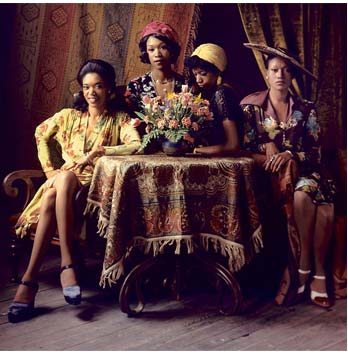
The Oakland, California-born Pointer Sisters produced a bunch of classic music back in the early to mid-seventies. Their career lasted well into the new millennium but for now I focus on when they were a quartet: Ruth, Anita, Bonnie and Jean.
By 1976 they became a trio when Bonnie left. The trio took a more contemporary and rock-influenced direction. Eventually only Anita and Ruth of the three singers billed as the Pointer Sisters were original members. The third singer was Issa, who was Ruth’s daughter, and for a New Year’s Eve gig, December 2010 in Singapore the third singer was Ruth's granddaughter Sadako Ruth Johnson.
Some argue that the Pointer Sisters fell off when they switched directions. Fans retort that they won more awards, sold more and amassed far more chart recordings as a trio. Rather than a fall off, there simply was greater success in a different direction.
Many people don’t understand how hard it is to stay at the top of the entertainment industry after four or five good years. These sisters have over three decades of success and whether or not we like their style, we ought to respect their achievements. Which brings me to what I consider their classic work.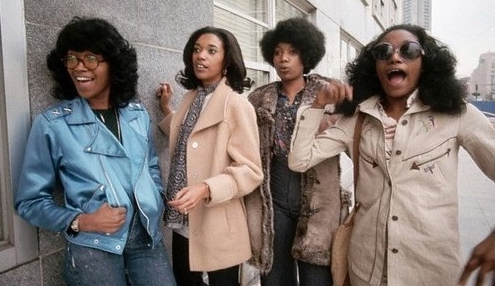
The Pointer Sisters hit the scene with a signature hit, Allen Toussaint’s “Yes We Can.” While crate digging for material to sing, they came across a Lee Dorsey album that included the Toussaint produced and written song.
“We believe that, and when we started out, that was our theme. You know, yes we can. We found this song [by Allen Toussaint] on an old Lee Dorsey album and said, ‘This is what we want to tell the world.’ ”And that was their modus operandi: search through their musical legacy and re-vamp the material while also producing fresh additions to the tradition.
—Anita Pointer
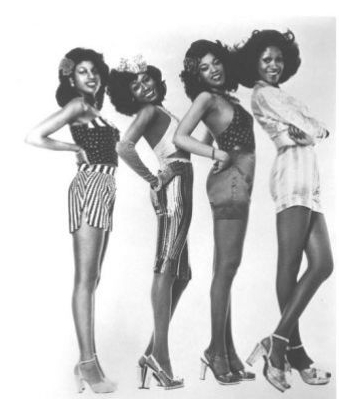
They were four willowy, black women with incredible harmony and a profound respect for black musical traditions. Additionally, they had the skill and the will to invest the material with a vim and vigor worthy of jazz soloists.
Of course LH&R (Lambert, Hendricks and Ross, who pioneered vocal reproductions of modern jazz songs and solos) set the standard for this jazz choral singing. They were following in the tradition of the Mills Brothers. What was significant however is that the Pointers were an all female outfit who covered the waterfront rather than sticking up to cutesy, girlie type of arrangements and selections.
The Pointer Sisters intelligently approached the broadest range of popular black vocal music. It is interesting that they did not record any overt gospel vocals even though, as the daughters of Sarah and Elder Elton Pointer, a minister at The West Oakland Church of God, the six Pointer siblings were brought up in the church tradition.
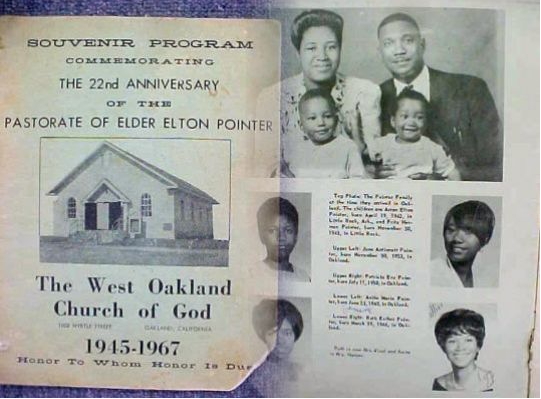
Younger brothers Fritz and Aaron were the two siblings, and oddly, neither of them were interested in singing with their sisters. But then again, the Pointer household was very strict about music and anything other than religious music was forbidden. Ruth describes their upbringing as one big “no”— "No jewelry, no makeup, no dancing, no movies, and certainly no rock music. Daddy wanted to protect us from what he called 'the devil's work,' and he worked hard to make sure he did."
Typically, they rebelled against their strict upbringing and enthusiastically embraced secular forms of the music, mostly what they heard on the radio and in the homes of friends. Growing up literally in poverty, they spent most of their childhood entertaining themselves using the only instruments they could afford: their own voices.
Their initial efforts hit a literal dead end. In 1969 they got stranded in Houston, Texas and their parents could only afford to get a return ticket for one, June. What to do? As they say in church, God works in mysterious ways. Bonnie had heard of David Rubison but had never met him. Bonnie recalls she mustered up the courage and made a cold call. "I called him and said, 'You don't know us, and you've never heard us sing, but please trust us and help!' ”
David did; he sent money for travel expenses and when they got back to the area began arranging for the sisters to sing backup on gigs for others and eventually backup on recordings. During this period the Pointer Sisters signed to Atlantic Records but their first single, “Don’t Try To Take The Fifth,” went nowhere. Shortly thereafter David Rubinson started his own record label, Blue Thumb and signed the sisters. Unlike Atlantic who tried to mold the Pointers as another R&B singing group, Rubinson was in tune with the Pointer Sisters chosen direction. Their first release: “Yes We Can Can.”
The Pointer Sisters blossomed into a trend-setting vocal group who combined scatting with a wide range of black musical styles. Paradoxically, their first Grammy was awarded for a country and western song written by Anita with some finishing touches from Bonnie.
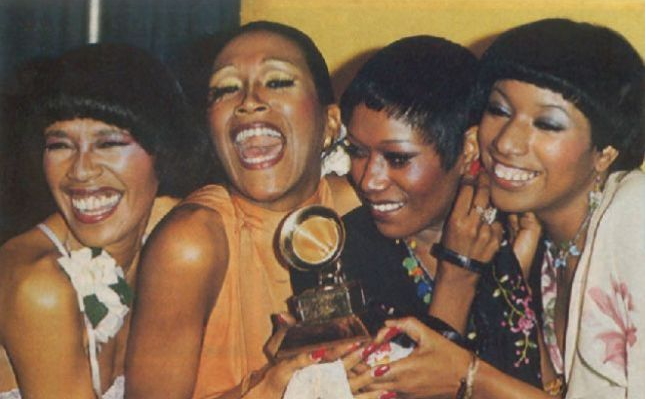
The Pointer Sisters were the first black female group featured at Nashville’s The Grand Old Opera. However, the Opry show didn't go off without at least one hitch:
"We got onstage to sing the song, and a guy from the audience stood up and said, 'Well, hot damn, them gals is black!' " Anita laughs. And despite being the toast of the town, that lack of visibility caused other problems in Opryland as well--ones not surprising to four young black women exploring unchartered terrain. "When we first performed at the Grand Ole Opry, the audiences loved us," Anita recalls. "But at the hotel where there was a party for us, the staff assumed we were the hired help and directed us toward the back door."
—Pointer Sisters Website
Significantly, they did not try to produce 72 more C&W songs to capitalize on their Grammy success. Instead they went deeper into R&B, and then as a trio turned to rock, disco and contemporary eighties pop. But back to the classic material. Willie Dixon, the master composer of blues, crafted “Wang, Dang, Doodle,” which is one of their most loved songs. But deeper still is their rendition of Mississippi Delta blues giant Son House’s “Grinnin’ In Your Face.”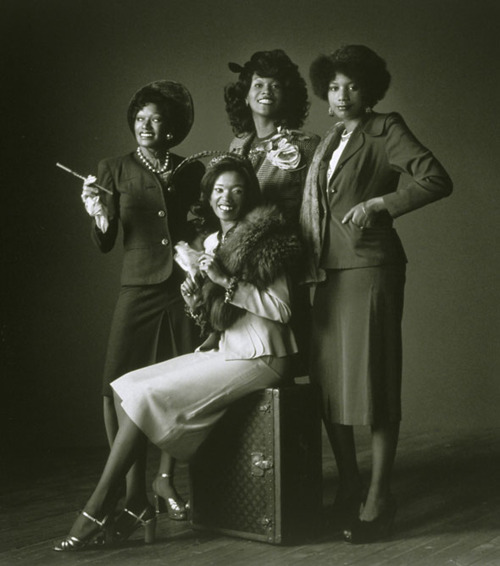
Their retro-costumed stage presence complemented the range of their repertoire but also restricted their appeal among national audiences. Ruth notes that their stage dress was an eclectic mix “from our mom's friends, the garages, the attic, the thrift stores.” Detractors point to this as part of their proof that the sisters had identity issues. I believe, in fact, what we see with the Pointer Sisters are women embracing a wide swath of their ethnic heritage without limiting themselves to one style in order to fit into pre-conceived marketing notions of what will sell and what won’t sell.
Yes, there is a big audience beyond jazz, blues and R&B, but at the same time there is no other music quite like the intense excitement generated by the core elements of secular black music—yes, gospel is equally exciting, however the well kept secret of gospel is that gospel is church music that has been influenced by jazz, blues and R&B.
Without going too far away from our focus on the Pointer Sisters, it is important to realize that what most of us know as gospel came via Thomas Dorsey (who was Ma Rainey’s piano player and million selling blues artist before a religious conversion) and Mahalia Jackson (who was from New Orleans and brought that flavor to her music). In any case, classic Pointer Sisters material emphasized the jazzier sides of their approach to the music even when they were doing stomp down blues such as “That’s How I Feel.”
During their classic period, David Rubinson was the manager of the Pointer Sisters. Rubinson also managed Herbie Hancock. That’s Herbie and guitarist David “Wah Wah” Walker featured on “How Long (Betcha’ Got A Chick On The Side).” Both the sisters and Rubinson were serious about their jazz connections.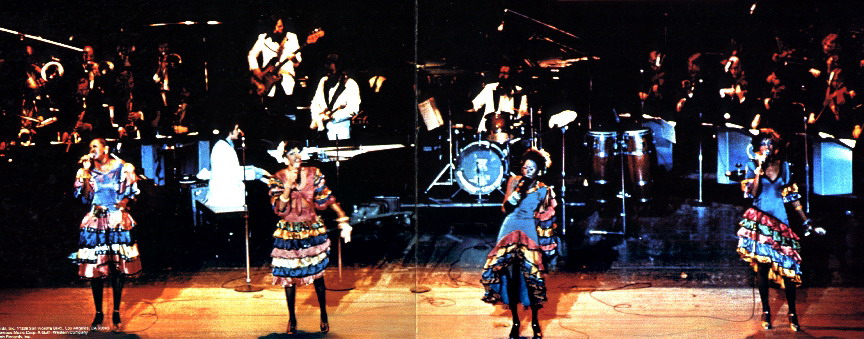
Their live album offers the full range of their classic repertoire and is especially illustrative of their jazz improvisational side in the nine-minute feature song “Love In Them There Hills” that utilizes a Brazilian flavor. They segue effortlessly from the funk of “Yes We Can Can” using their voices as percussive instruments.
By the end of their tenure with Rubinson, they were headed in a heavy R&B direction and thus the sound of the fifth and final album of classic material the emphasis on newer material with a heavy back beat. The last song may sound like it has a Minnie Riperton flavor but it’s actually the greatest R&B composer of the last half of the twentieth century.
Stevie Wonder wrote “Bring Your Sweet Stuff Home To Me” with its distinctive harmony line, and when we remember that Minnie not only was a member of Stevie’s backing singers, Wonderlove, but that Stevie also wrote a number of songs for Minnie and recorded on Minnie’s later albums, then we can easily connect the dots. (Someday we’re going to have to do Stevie wonder material written for and/or recorded with other artists—during the seventies the man was all over the musical map making numerous behind the scenes contributions.)
And speaking of different flavors, don’t miss the collaboration composition (Isaac Hayes, June, Bonnie & Anita Pointer) “Easy Days.” Over and over our sisters evidence their ability to join with diverse elements of our heritage to produce wonderful music.
Perhaps, we should note that producer David Rubinson was much more oriented toward black music traditions than was Richard Perry who switched the Pointer focus to rock and disco. Too often what is produced is not simply (and almost never solely) whatever the artist chooses but rather what's presented to (pushed on or marketed to) the public is usually whatever record company executives and producers think will work commercially. In terms of sales, Richard Perry was an excellent producer but in my book popularity does not necessarily equate with classics.
The tension between classic and commercial is the subtext of the entire history of recorded black music. Three decades plus of work by The Pointer Sisters perfectly encapsulates this paradox: the best music is often a comparative failure commercially. But rather than bemoaning or trash-talking about selling out, I think we should give thanks for what we have. 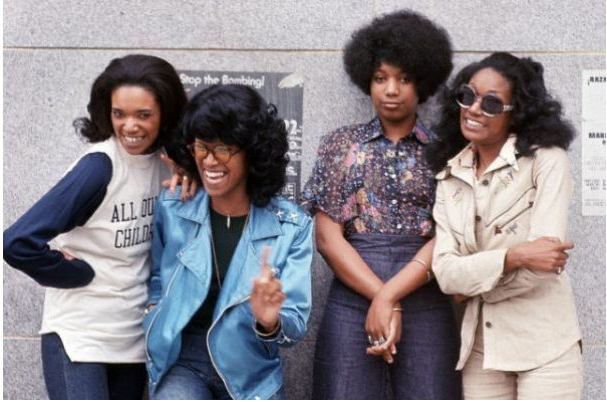
Thank you Anita, Ruth, June and Bonnie Pointer for the beautiful music you gifted to us and to future generations of music lovers.
—Kalamu ya Salaam
Pointer sisters Mixtape Playlist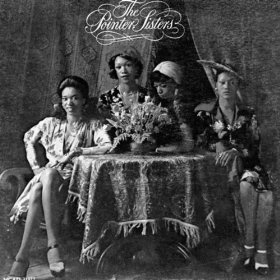
The Pointer Sisters
01 “Yes We Can Can”
02 “River Boulevard”
03 “That's How I Feel”
04 “Wang Dang Doodle”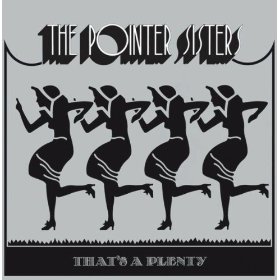
That's A Plenty
05 “Grinning In Your Face”
06 “Shaky Flat Blues”
07 “Little Pony”
08 “Fairytale”
09 “Black Coffee”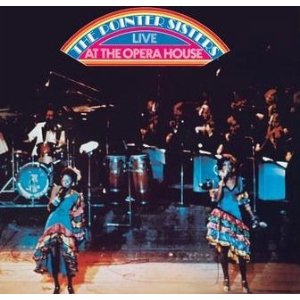
Live At The Opera House
10 “Cloudburst”
11 “Salt Peanuts”
12 “Yes We Can Can”
13 “Love In Them There Hills”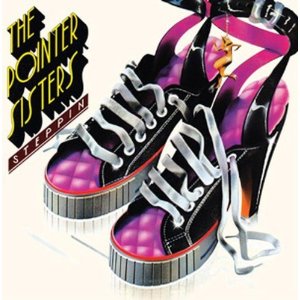
Steppin
14 “How Long (Betcha' Got A Chick On The Side)”
15 “Easy Days”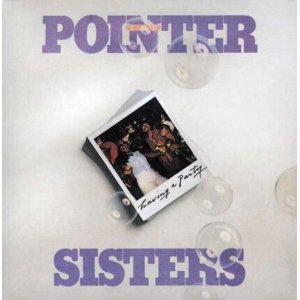
Having A Party
16 “I Need A Man”
17 “Bring Your Sweet Stuff Home To Me”
This entry was posted on Tuesday, January 4th, 2011 at 7:58 am and is filed under Classic. You can follow any responses to this entry through the RSS 2.0 feed. You can leave a response, or trackback from your own site.
7 Responses to “POINTER SISTERS / “Pointer Sisters Mixtape””
January 4th, 2011 at 8:30 am
Love this post. This post focused on the sister’s recordings themselves. But I think their back-up singing might deserve a post of its own. I was intrigued and inspired the stuff they did with Taj Mahal. (Frankie and Johnny, for example) I was excited by the stuff they did with Sylvester. (I may be getting things confused here. Did they also do back-up – with Sylvester – for Betty Davis?)
January 4th, 2011 at 8:35 am
The Duke Ellington medley on the Pointer Sisters’ Steppin album is one of my favorites. I just recently discovered that they used virtually the same arrangement that Aretha, Sarah Vaughan, Roberta Flack and Peggy Lee did on a 1973 Ellington special – which is on Youtube.
January 5th, 2011 at 3:20 am
Black music at its finest 🙂 and great backing bands special kudos to the rhythm sections 🙂
January 10th, 2011 at 7:41 am
The Pointer Sisters made Allen Toussaint’s “Yes We Can Can” an anthem, a song with passion and emotion. This group is THE powerhouse all “girl” group that pulls atcha heart, mind, and soul. Thanks again, Kalamu, for bring it.
May 31st, 2015 at 8:41 am
Nice insights. I got hooked by The Pointer Sisters after listening to their debut “eponymous” album in 1973 … played that vinyl so much … it should of wore out but never did, my parents put up with it cause I guess they liked it too! Many years later my love of these ladies was rekindled and I was hooked all over. I made a fan page: http://www.pointersistersfanpage.com
and I will put a link to your fine article on it.
June 11th, 2015 at 3:26 pm
Good stuff respecting early Pointer Sisters up to but not including the Richard Perry produced trio. Is that a nock on their highly successful years making dance/pop music. Keep in mind Perry did producing for a lot of great black singers, including Ray Charles, Ella, Diana, Martha Reeves, Fats Domino, etc. The P.S. “Right Rhythm” album was produced and released by Motown 1990. And they later did an album and tour for “Ain’t Misbehavin!” So I don’t believe the Pointer Sisters actually ever did cut from black music. I’m a big-time lover of the Pointer Sisters but I don’t trak much on their early work as back-up singers. For me they were (the) pre-emminent rock, r&b, jazz, disco, pop, country “sister” group.
Leave a Reply
| top |